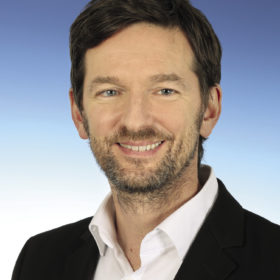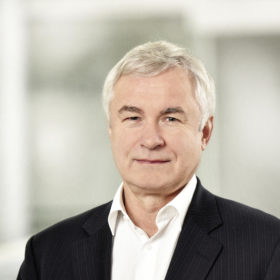Earlier this year, VW announced a supply chain performance rating, to take environmental impacts and social responsibility into account. What is this about?
Marko Gernuks: We are going to be CO2 neutral in 2050. We have set a milestone in 2025 where we want a carbon dioxide reduction of 30% of our fleet. The question is: How can we get this in the most cost efficient way?
One step is our new electric vehicle, ID, which is going to be delivered CO2 neutral. We are going to be CO2 neutral at our manufacturing plant in Zwickau, Germany. We also got a commitment from our battery supplier that they will use green electricity for their production. This is a hot spot in the life cycle assessment, so it is a great step forward.
How will you ensure they are really using green electricity?
Günther Scherelis: An audit system will be introduced, to be online by the start of July. We have agencies visiting mines and companies – VW has 40,000 suppliers worldwide. Another issue is human rights: No slave or child labor, for instance, is tolerated.
Are you looking at materials such as cobalt in terms of sustainability?
Cobalt is a conflict material and we are fully aware of this. We try to achieve transparency, although in an environment where there is no security, it is hard to trust any certification. So, nobody has 100% transparency. But we are working on this. We are also working on reducing the amount of cobalt we use.
How are you doing this?
MG: At the moment the batteries are one part nickel, one part cobalt, and one part manganese, so 1:1:1. In the next generation, we will have 6:2:2, so 60% nickel, 20% cobalt, 20% manganese. Then we will have 8:1:1, so 80% nickel and just 10% cobalt and 10% manganese. We are also thinking about reducing cobalt to 5% or even lower. 6:2:2 we will finalize in the next year, and the 8:1:1 will come some years later.
You recently joined up with Swedish battery manufacturer Northvolt to create the European battery union. What do you hope to achieve with this?
The new consortium is to be led by the Volkswagen Group and Northvolt. Joint research will cover the entire battery value stream – from raw materials through cell technology to recycling.
What plans do you have in place for battery recycling?
GS: At the moment, we are setting up test recycling at our Salzgitter plant in Germany. We have to see how the batteries are performing in real life. It’s not that after one car life they go to a recycling plant – we will test them for a second life. We expect larger quantities at the end of the 2020s.
MG: We started to research the recycling issue in 2009 and there are two different routes of recycling. One, you melt the batteries and you get the valuable materials. The other, which we are favoring, is where you shred the module, put it through a drying process, to end up with a pile of black powder. In there, you find the lithium, cobalt, and nickel. You then treat it hydrometallurgically, where you recover the raw material from sustainable chemical processes. Then the raw materials can be used in new battery cells. It’s working quite well. It’s just a question of capacity.
What percentage of materials can you retrieve from the recycling process?
Recyclers state they can recover 90% of the cobalt and nickel from a battery. In pyrometallurgical processes, the lithium, as far as I know, is going to slag and it is quite difficult to get it out of there – maybe around 50%. The way we are doing it, we get the lithium in a solution. Like this, it is easier to get it back. Our idea is to get more than 70%.
Ninety percent sounds like a great number when you look at it, but you end up in 100 years at just 30%. Is it really sustainable from this perspective?
GS: I doubt we will have batteries the same size in 20 years. We are working on solid state batteries and they are completely different – they have higher energy densities. Considering all these conflict minerals, all manufacturers are working on alternatives. These calculations won’t work in reality.
Are you looking at other energy storage technologies?
We are also working on hydrogen power to x, and hydrogen for fuel cells. The question is, if you have one kilowatt hour of green electricity, do you put it in a battery electric vehicle, or do you go down the hydrogen pathway? Where we have to do electrolysis, and then you have to bring the hydrogen to the filling station, then people must trade it up to be compressed, then the hydrogen has to be re-transferred into electric energy, and there’s another 50% loss. So we end up with quite a poor overall energy [transfer] compared to electric vehicles. However, for long distance travels or specific use cases the fuel cell electric vehicle might be the better choice.
GS: We are focusing primarily on the battery electric vehicle, because what we are doing now is not just replacing the combustion engine with an electric engine – we are changing the whole system.
A car with a combustion engine contains 3,000 to 4,000 parts. The electric vehicle has about 1,200. A lot of value added will be produced in the manufacturing stage, where you also have a much bigger CO2 footprint. Also, today you have gas stations, but in the pure electric future, we won’t need these anymore. What will the people do, what will the stations do, what will the companies which sell the parts do? You don’t need as many people for assembling the cars. This completely changes the system and that is underestimated at the moment. Also, we are going to have tens of thousands of EVs on the market in the next years, but there is a lack of charging infrastructure. This is a problem.
What is VW doing in this area?
At the moment we have our own charger business, Ionity, which is a joint initiative with Daimler, BMW, and Ford. We are working on all the major motorways throughout Europe to install charging spaces every 120 km. We already have about 40 or 50 of these stations. We are also offering wall boxes for consumers to charge EVs at home, but this is not enough. Interview with Becky Beetz
Volkswagen’s spokesperson for environment and sustainability Günther Scherelis (below) , and life cycle assessment specialist, Marko Gernuks (above).


This content is protected by copyright and may not be reused. If you want to cooperate with us and would like to reuse some of our content, please contact: editors@pv-magazine.com.

